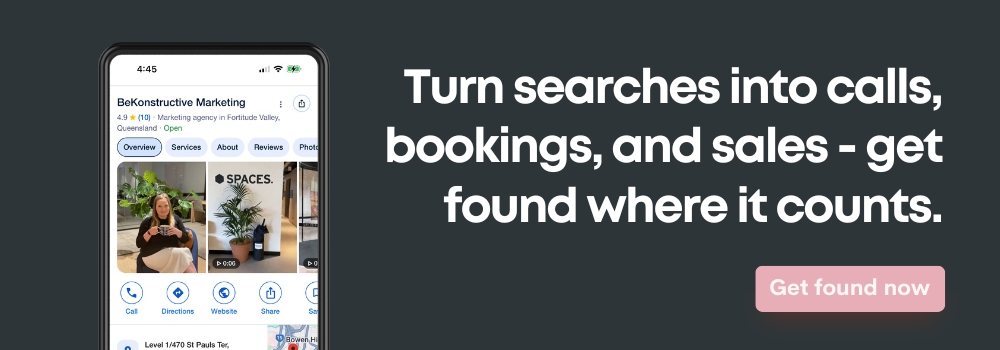Discover 5 powerful Google Business Profile tips to attract more customers, boost sales, and improve your local visibility. Learn lesser-known optimisation strategies that go beyond reviews.
If you’re like most small business owners, you set up your Google Business Profile (you know, that Google box that shows your phone number, address and reviews) years ago and haven’t thought much about it since. Maybe you log in every now and then to check reviews, especially if your competitor down the road suddenly has more stars than you.
But otherwise? It’s probably been a bit of a “set and forget.”
Here’s the thing: that little Google box isn’t just a place for your contact details. When managed well, it can be one of your biggest drivers of calls, foot traffic, and sales. If you leave it dormant, you’re missing out on prime opportunities to show up in searches and get found by new customers.
So, let’s cut to the chase. Here are 5 quick wins you can apply to your Google Business Profile that go beyond the obvious “get more reviews” advice:
- Categories: Make sure your primary category is correct and then load up on secondary ones too.
- Posts: Don’t just repurpose your Instagram – use weekly posts for sales-driven promos and offers.
- Products & Services: Flesh these out with detailed descriptions (and juicy keywords) so you show up in more searches.
- Opening Hours: Extend them if you can – Google favours businesses that are open and available.
- FAQs: Add your own questions and answers to save customers the hassle (and sneak in extra keywords).
👉 And as a bonus tip: be strategic when you update your business info so Google doesn’t flag you as spam and suspend your profile.
Stick with me, and we’ll break each of these down with practical examples so you can turn your Google Business Profile into more than just “that Google box” – we’ll make it a lead-generating machine.
✨ Pro tip: If all of this feels like a lot, that’s because it is. Keeping your Google Business Profile fresh and optimised takes time and know-how. Our monthly Get Found Local service takes it off your plate – we manage your profile (plus a bunch of other local SEO goodness) so you can focus on running your business while we focus on getting you found.

Categories: Go Beyond the Obvious
When you first set up your Google Business Profile, you pick a primary category. Most people stop there. Big mistake.
Why it matters
Your category is one of the strongest signals Google uses to decide what searches you show up for. It works hand-in-hand with location to decide who sees you in that little local pack (aka “the Google box”).
What to do
- Nail your primary category: make sure it’s the one that best represents your business.
- Add secondary categories: don’t leave these blank! Even if they only cover a slice of what you do, add them. There’s no penalty for stacking relevant categories.
Example: BeKonstructive’s primary category is Marketing Agency. But we’ve also added Internet Marketing Service as a secondary. Do we describe ourselves that way? Nope. But it’s relevant enough that it helps us show up in more searches.
Builders who do renovations, cafés that also do catering, hairdressers that specialise in extensions – all of these should be adding those secondary categories. The more relevant signals you send to Google, the broader the net you cast for potential customers.
👉 Bottom line: don’t just settle for one category. Load up on all the relevant ones and give Google more reasons to show you off.
Posts: Think Sales, Not Social
Most businesses either don’t touch the “Posts” feature on their Google Business Profile, or they just copy-paste something from Instagram. That’s not how this works.
Why it matters
Google Posts only stick around for 7 days, which means if you’re not posting weekly, your profile looks like a ghost town. Worse still, when you do repurpose social content, it’s usually brand-building or educational – fine for social media management, but not what converts on your Google listing.
What to do
- Post at least once a week: keep your profile looking fresh and active.
- Make it promotional: highlight offers, deals, events, pain points you solve, or standout benefits. Think: “Free WiFi and vegan options” if you’re a café, or “No lock-in contracts” if you’re a service business.
- Recycle strategically: you don’t need 52 brand new ideas every year. Build a bank of 10-12 strong promotional posts and rotate them. Nobody’s scrolling back through your Google posts – it’s always a fresh audience.
Example: At BeKonstructive, one of our big selling points is that our whole team is Brisbane-based. We highlight that in posts because it speaks directly to customer concerns about outsourcing. A restaurant might promote its lunch specials. A gym might showcase its free trial offer.
👉 Bottom line: treat Google Posts like your mini billboard. Keep it performance-driven and focused on the one key message a first-time customer needs to see.
Products & Services: Flesh It Out
Most businesses spend less than an hour setting up their Google Business Profile, dump a couple of products or services in, and never touch it again. Fast forward a couple of years and the business has evolved – but the profile hasn’t.
Why it matters
The “Products” and “Services” sections aren’t just filler. They’re prime real estate for keywords. Google reads those descriptions and uses them to match you with searches. If you’ve only listed your core service, you’re cutting yourself short.
What to do
- Update regularly: as your business grows or pivots, your profile should too.
- Get specific: don’t stop at “Social Media Management” – break it down into Facebook Management, LinkedIn Management, TikTok Management, etc. Each one is another hook for Google to match with searches.
- Write keyword-rich descriptions: keep them natural, but include the terms people are actually searching for.
- Align with your website: anything you add here should also exist (even if briefly) on your website to avoid looking spammy.
Example: An air-conditioning company shouldn’t just list “air conditioning.” They should break it out into “installation,” “repairs,” “servicing,” and even list out the types of units they stock. A restaurant can upload its entire menu – so if someone searches for “Caesar salad near me,” they’ve got a fighting chance of showing up.
👉 Bottom line: the more you expand your products and services (while keeping them aligned with your website), the more ways Google has to match you with paying customers.

Opening Hours: Stay Open, Get Found
Your opening hours aren’t just handy for customers – they’re actually a ranking factor in local search. Yep, Google cares about when you’re open.
Why it matters
When someone searches, Google looks at where they are and what’s open right now. If it’s 4:30pm and most places nearby close at 5, Google will prioritise businesses that are still realistically open and available. That means if your hours are too restrictive, you might get buried – even if you’re the better option.
What to do
- Don’t shorten your hours unnecessarily: closing them off early online (e.g. saying 4pm when you’re actually there until 5) can cost you visibility from mid-afternoon onwards.
- Extend where possible: if you’ve got staff on staggered shifts, reflect that. Maybe you’re not taking full meetings at 6pm, but if someone can answer the phone, keep your profile open.
- Think like your customer: late-night searches for haircuts, florists scrambling for last-minute anniversary flowers, tradies looking for a café at 6am – those are the moments where being “open” wins you the customer.
Example: At BeKonstructive, our core hours are 9-5. But because team members start early and others finish late, we’ve listed 7:30am-6pm as our opening hours. That way, if someone Googles “content marketing agency Brisbane” at 5:15pm, we’re more likely to appear than an agency that’s marked themselves closed at 5.
👉 Bottom line: within Google’s guidelines, keep your hours as broad as you can. Being “open” when your competitors aren’t is an easy way to get a visibility edge.
FAQs: Ask (and Answer) Your Own Questions
When most people see the FAQ section on their Google Business Profile, they assume it’s for customers to leave questions. That’s true – but here’s the kicker: nothing stops you from asking (and answering) your own FAQs.
Why it matters
This is free space to add more helpful info and more keywords. It saves your customers from clicking around your website for simple answers, and it gives Google more reasons to show your profile in search results.
What to do
- Pre-empt common questions: dress codes, parking, BYO, child-friendly facilities, delivery options, payment methods – whatever people ask you all the time.
- Be detailed: don’t just say “yes” or “no”. Use the space to add context and relevant keywords.
- Think about barriers to entry: what objections or doubts stop people from booking or visiting you? Address those here.
Example: A restaurant could add:
- “Are you licensed?” → “Yes, we’re fully licensed and also offer BYO wine with a $5 corkage fee”.
- “Do you have kids’ facilities?” → “Yes, we have a fully enclosed play area for children”.
Not only does this answer customer questions upfront, but it also helps you rank for searches like “licensed restaurant with kids’ playground near me”.
👉 Bottom line: don’t leave your FAQ blank. Populate it with smart, keyword-rich Q&As that give customers (and Google) exactly what they need.
Bonus Tip: Update Strategically to Avoid Suspensions
Here’s a not-so-fun fact: if you make too many big changes to your Google Business Profile in one go, Google might flag you as suspicious and temporarily suspend your listing. That means you vanish from search while they manually review your account – not ideal when you rely on it for leads.
What to do:
- Tackle core changes last: if you’re moving offices or rebranding, update your website and socials first, then change your Google Business Profile so Google can cross-check the info.
- Make changes gradually: don’t change your name, phone number, and address all in one hit. Spread updates out to avoid triggering a manual review.
- Update in bulk only for safe areas: posts, photos, products and services can be updated anytime without risk.
👉 Bottom line: be slow and steady with major profile changes to keep your listing live and avoid the headache of a suspension.
Wrapping It Up
Your Google Business Profile isn’t just “that Google box” with your phone number and reviews. It’s a powerful tool for driving calls, visits, and sales – but only if you actually give it some love. By fine-tuning your categories, posting weekly, expanding products and services, stretching your opening hours, filling out FAQs, and managing updates carefully, you can turn it into a lead-generating machine.
✨ Want it done for you? Our Get Found Local service takes care of your Google Business Profile – plus other local SEO essentials like reviews, directory listings, and optimisation strategies. We’ll manage the nitty-gritty so you can focus on running your business, while we make sure your customers can find (and choose) you.
👉 Learn more about Get Found Local here
About the Author: Bek Drayton is the founder and Managing Director of BeKonstructive Marketing, a Brisbane-based agency specialising in SEO, content marketing, and marketing communications. With over a decade of hands-on experience helping local businesses grow through Google Business Profiles and local SEO strategies, Bek is passionate about turning “that Google box” into a powerful sales tool for everyday businesses.



